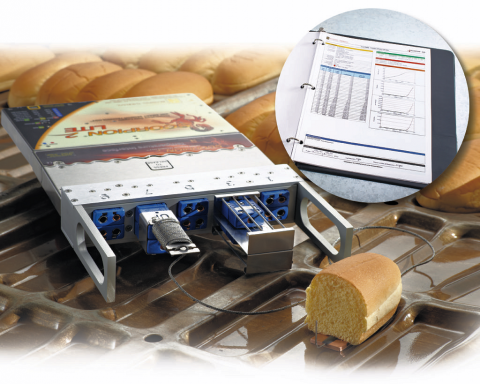Consider the SCORPION® 2 Temperature Sensor from Reading Thermal to measure the parameters of your industrial ovens that affect the quality of your products. Our state-of-the-art profiling systems offer an easy way to validate your kill step for food safety and FSMA compliance.
Reading Thermal has been studying the commercial baking process for more than 25 years. We manufacture and support the SCORPION® 2 Data Logging Measurement System, which is now a standard in the global baking industry.
Why Measure Oven Temperature?
Oven temperature causes chemical and physical reactions in dough/batter, and temperatures that are too low or too high during baking can lead to changes in fermentation and humidity levels and undesirable variations in surface coloring, texture, and flavor.
If you manufacture bread, artisan bread, rolls, hamburger buns, cakes, biscuits, or other bread products, you understand that several stages are temperature-dependent, such as oven-spring, drying/dehydration, and color formation. Too much heat coming from one direction in the oven, for example, can cause the bottoms of the loaves to burn before the crusts can brown properly.
The SCORPION® 2 Temperature Sensor Array measures the temperature at the product level, in fixed positions across the conveyor, and provides you with an accurate representation of what your product experiences over time. We offer different types of pluggable sensors, including an option for solid or tight mesh conveyors and one for open mesh conveyors.
The sensor array is connected to the SCORPION® 2 Data Logger and then travels through the oven with the product (with the oven under full load), yielding a precise picture of temperature from side-to-side and end-to-end.
Product-core-temperature measurements can also be made simultaneously via the product probe inputs on the sensor array. This can make the difference between excellent quality and an under-baked or burnt product.
Measuring Other Baking Parameters
Air velocity: Measuring oven air velocity is critical because it influences the texture, coloration, firmness, and baking time of the final product. Oven air velocity can be measured and recorded with the SCORPION® 2 Air Velocity Sensor which paints a precise picture of airflow patterns inside the oven from side to side and end to end.
Heat flux: Oven heat flux is the very best indicator of oven performance during baking. Many bakers use oven heat flux profiles when trying to produce the same product on two different lines. The two lines will produce the same product when the heat flux profiles match. The SCORPION® 2 Heat Flux Sensor measures convective and radiant heat fluxes at product level and displays the results in Btu/hr·ft2 or W/m2.
Humidity: Humidity in the oven often comes from the product itself and represents a delicate balance that affects finished product quality in many ways; e.g., the amount of moisture left in a pretzel can affect its shelf life, while less evaporation can keep the surface of a cookie moist, allowing it to stretch, preventing cracks. The SCORPION® 2 Humidity Sensor is designed to measure the absolute moisture content of the thermal environment in both your heating and cooling processes.
If you are seeking temperature profiling systems for industrial ovens, contact Reading Thermal online, or get in touch with our headquarters in Sinking Spring, Pennsylvania at (610) 678-5890 Ext. 2 to learn more about our innovative products.

